Best 4K Gaming Monitors for PC 2024: 144Hz, Curved and More
These are the best 4K gaming monitors to consider if you're ready to upgrade your gaming experience.
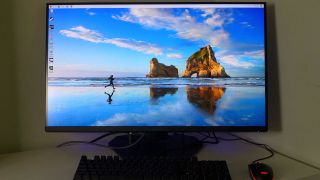
The list in brief
1. Best Overall
2. Best Mini LED
3. Best OLED
4. Best Premium
5. Best 155Hz
6. Best 144Hz
7. Best Value
8. Best for HDR
9. Best Budget
10. Best for Consoles
11. Shopping Tips
As mainstream graphics cards become even more powerful, it's not surprising that PC gamers are taking more of an interest in monitors with a 4K resolution. A panel packing 8.3 million pixels (3840 x 2160) makes your favorite games look sharp and realistic. However, that 4K resolution requires a graphics cards that it is capable of delivering high enough frame rates to make games playable.
In addition to being one of the most popular resolutions available in a good gaming monitor today, going 4K also offers the ability to expand to larger displays while retaining a sharp image. With a packed pixel army, you can stretch your screen size well past 30 inches without having pixels so large that you can see them.
But that image quality can often come at a steep price. Anyone looking for a 4K monitor knows they're not cheap. Yes, 4K is about high-res gaming (and other media), but you'll still need solid gaming specs, like a 120 Hz-plus refresh rate, low response time, and your choice of Adaptive-Sync (Nvidia G-Sync or AMD FreeSync, depending on your system's graphics card). And you can't forget the cost of the powerful graphics card you'll need to game properly in 4K. See our Best Gaming Monitors page for lower-resolution recommendations if you're not ready to fully embrace 4K.
The Quick List
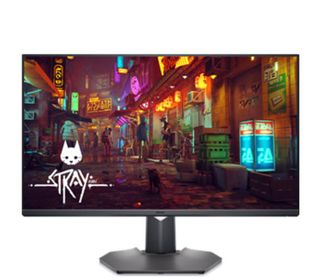
Best 4K Gaming Monitor
The Dell G3223Q hits all the right buttons for most people looking for a 4K gaming monitor. It features a 1ms response time, 144Hz refresh rate and supports both AMD and Nvidia's brands of Adaptive-Sync. Throw in excellent accuracy, a colorful image and a price tag of around $800, and you have a compelling monitor option for gamers.
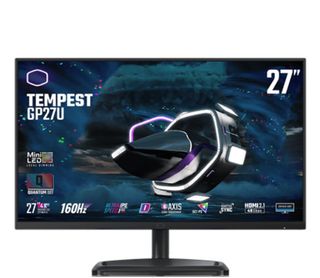
Best Mini LED 4K Gaming Monitor
Mini LED technology is increasingly emerging in the gaming monitor segment, and the Cooler Master Tempest GP27U is among the best available. The monitor features 576 dimming zones to improve contrast and contribute to a sharp and colorful image. And while 144Hz is the segment average for refresh rates at 144Hz, the Tempest GP27U bumps that to 160Hz (although you do lose Adaptive-Sync if you cross the 144Hz barrier).
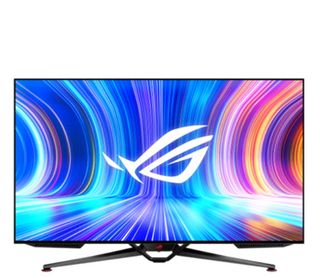
Best OLED 4K Gaming Monitor
The Asus ROG Swift PG42UQ hits the ground running with a stacked deck when it comes to performance, thanks to its OLED panel. Not only did Asus deliver a monitor that is accurate fresh from the factory, but it also delivers a bright and colorful picture with low input lag and class-leading input lag. A bonus is the inclusion of speakers that actually sound good (which is a rarity for gaming monitors).

Best Premium 4K Gaming Monitor
If you want speed, look no further than the Samsung Odyssey Neo G8. Most 4K monitors hit 144Hz or overclock to a maximum of around 170Hz. The Odyssey Neo G8, however, has a native refresh rate of 240Hz. Combined with smooth motion processing and low input lag, the Odyssey Neo G8 is "next-level" for gamers looking to pair with a GeForce RTX 4090 or Radeon RX 6900 XTX.

Best 155Hz 4K Gaming Monitor
The Asus ROG Swift PG32UQ impressed with a zone-dimming edge-lit backlight. This boosts contrast and contributes to a picture with excellent HDR contrast. Color reproduction is also impeccable, as is the accuracy of the images.

Best 144Hz 4K Gaming Monitor
Philips continues to impress with its latest gaming monitors, particularly with the Momentum 279M1RV. While 144Hz at 4K might seem run-of-the-mill, Philips pushes the limits with excellent video processing, perfect color and a bright picture. The icing on the cake is Philips' Ambiglow technology, which provides bias lighting for a more immersive gaming experience.
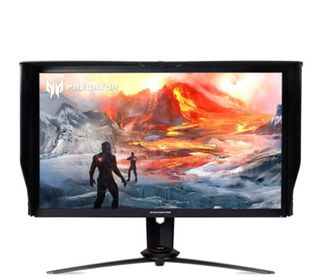
Best 144Hz 4K Gaming Monitor Value
While many high-end 4K gaming monitors can run $800 or more, the 27-inch Acer Predator XB273K regularly sells for less than $600. That price gets you professional-level color accuracy, excellent gaming performance, and factory-fresh color accuracy.
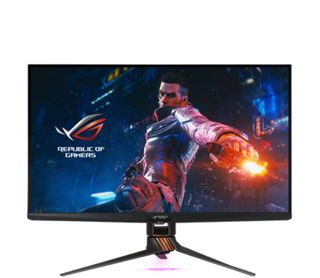
Best 4K Gaming Monitor for HDR
The Asus ROG Swift PG32UQX is an interesting selection, thanks to its use of a Mini LED panel with excellent contrast and a bright screen (1,627 nits in our testing). Asus even includes a small OLED screen called "Live Dash" that displays refresh rate, picture mode, and CPU/GPU temps.
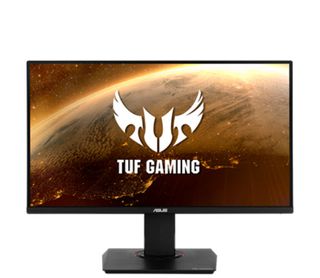
Best Budget 4K Gaming Monitor
The Asus TUF Gaming VG289Q represents an excellent value for gamers, with a 4K resolution at 60Hz backed by AMD FreeSync compatibility. You won't find 144Hz refresh rates here, but you do get accurate color and a low price of just $289 (even less when on sale).
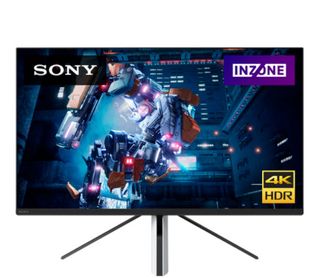
Best 4K Gaming Monitor for Consoles
Sony has developed the perfect monitor companion for its popular PlayStation 5 console: the Inzone M9. This is a 27-inch gaming monitor that supports all of the video capabilities of the PlayStation 5 and even includes a matching color scheme. Even if you don't have Sony's console, it supports FreeSync/G-Sync and even a KVM switch for PC users.
Best 4K Gaming Monitors You Can Buy Today
Why you can trust Tom's Hardware
Best 4K Gaming Monitor
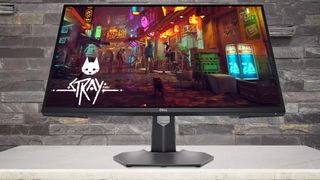
Specifications
Reasons to buy
Reasons to avoid
The Dell G3223Q is a stellar entry in the 4K gaming monitor segment, offering a 32-inch panel size, low total input lag (measured at just 30ms), and an excellent balance between response and motion resolution. As you might expect for a 4K gaming monitor, we have a 144Hz refresh rate with support for both AMD FreeSync and Nvidia G-Sync Adaptive Sync technologies.
Not only does the Dell G3223Q nail the basics, but it also offers a bright and colorful picture. And color accuracy straight out of the box is top-notch in both DCI-P3 and sRGB color gamuts. With DisplayHDR 600 support, accuracy and color reproduction were also well represented in HDR mode.
If there were any downsides, it was that contrast and color gamut volume came up a little bit short compared to some of its close rivals. However, with a street price of less than $800, the Dell G3223Q is easy to recommend for 4K gamers.
More: Dell G3223Q review
Best Mini LED 4K Gaming Monitor

Specifications
Reasons to buy
Reasons to avoid
Cooler Master is ramping up its gaming monitor portfolio, and the latest from the company is the impressive Tempest GP27U. The is on the smaller side for a 4K gaming monitor at 27 inches, but it brings a lot of features to the table along with excellent performance.
The headlining feature of the monitor is its Mini LED panel with a Quantum Dot film and 576 dimming zones. The result is an expansive color gamut and excellent image quality across the board. Of course, you’ll need to calibrate the Tempest GP27U to get the best performance, but once everything is dialed in, it impresses with deep blacks and overall color performance compared to its peers. On top of that, Cooler Master has thrown in support for up to 160 Hz refresh rates, although you can’t use Adaptive-Sync above 144 Hz.
The Cooler Master Tempest GP27U has loads of accolades on its plate and very few demerits of consequence. Throw in a relatively affordable price of $849, and you have a winning combination for gamers.
Read: Cooler Master Tempest GP27U 160 Hz Mini LED Review
Best OLED 4K Gaming Monitor
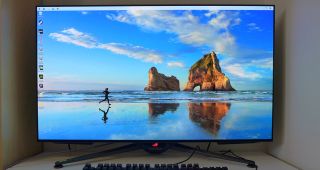
Specifications
Reasons to buy
Reasons to avoid
Asus is a formidable name in the gaming monitor space, offering entries for both mainstream and enthusiast customers. The company’s latest 4K gaming monitor, the ROG Swift PG42UQ, is a premium offering aimed at gaming enthusiasts that want excellent pictured quality backed by good motion resolution.
What makes the ROG Swift PG42UQ special is that it offers a vibrant OLED panel measuring 42 inches in size. You get 4K resolution (3840 x 2160), a 0.1 ms response time, and a native refresh rate of 120Hz (which jumps to 138Hz with overclocking). The ROG Swift PG42UQ excels in nearly every category, offering excellent color calibration out-of-the-box, top-notch video processing, low input lag, and hard-to-beat contrast (as afforded by its OLED panel).
As you would expect from Asus, the ROG Swift PG42UQ comes well-packaged and has premium construction throughout. Asus even includes a remote control for accessing the OSD and controlling the volume on the built-in speakers. In addition, a full allotment of ports is on deck, including two HDMI 2.0, one DisplayPort 1.4, and multiple USB 3.1 Gen 1 Type-A ports for connecting peripherals.
Read: Asus ROG Swift PG42UQ 4K OLED Gaming Monitor
Best Premium 4K Gaming Monitor

Specifications
Reasons to buy
Reasons to avoid
One thing you can expect regarding the vast category of 4K gaming monitors is that they all feature a 144Hz refresh rate (or slightly higher with overclocking). Well, Samsung bucks that trend with the Odyssey Neo G8, which offers a maximum refresh rate that is more fitting of a lower resolution 1440p monitor: 240Hz.
Not only does the 240Hz refresh rate put the Odyssey Neo G8 on a higher plane than its counterparts, but Samsung has infused the monitor with a 32-inch 1000R VA panel and Mini-LED lighting with 1,196 dimming zones. The superlatives didn’t end there; we were floored by the accuracy of the monitor fresh from the factory and image quality in both SDR and HDR modes were superb.
We only had a few reservations about the Odyssey Neo G8, namely its color gamut volume, which was mid-pack compared to its competitors. There’s also the issue of price. The Odyssey Neo G8 isn’t cheap, with an MSRP of $1,400. However, that price is a relative bargain compared to its Mini LED competitors from ViewSonic and Asus that retail for over $2,000 at this writing.
Read: Samsung Odyssey Neo G8 4K Monitor Review
Best 155Hz 4K Gaming Monitor
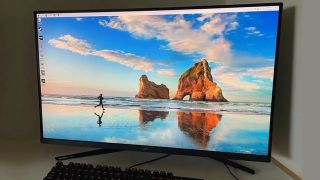
Specifications
Reasons to buy
Reasons to avoid
The 32-inch 4K gaming monitor segment is becoming very crowded, but the Asus ROG Swift PG32UQ looks to stand out with some trick features. For starters, the PG32UQ boasts a maximum refresh rate of 155 Hz, which pushes it slightly ahead of the class standard of 144 Hz.
While that 155 Hz rating didn't show much of an advantage in our testing, we can't ignore the rich and vibrant colors provided by the IPS panel and the excellent HDR contrast afforded by its HDR 600 rating. Throw in features like a large color gamut, 1ms response time, FreeSync and G-Sync compatibility and top-notch video processing, and we have a real winner on our hands.
The PG32UQ performed well across our test suite and comes in at a price that squeaks just below $1,000.
More: Asus ROG Swift PG32UQ review
Best 144Hz 4K Gaming Monitor
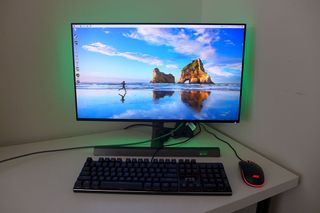
Specifications
Reasons to buy
Reasons to avoid
We have dozens of gaming monitors that pass through our lab yearly, but few monitors impress as much as the Philips Momentum 279M1RV. The 279M1RV packs in 4K resolution into a 27-inch IPS panel that impresses at every turn. You’ll find the usual 144Hz refresh rate, 1ms response time and Adaptive-Sync support expected from this class, but Philips goes above and beyond on the details.
The 279M1RV first impresses with its excellent picture quality. Not only is the display bright (hitting 458 nits in our testing), but it also performed well (for an IPS monitor) in the contrast test at 1,018:1. Color accuracy was at the head of the class, as was its HDR brightness and contrast. No calibration was needed out of the box with the 279M1RV.
Gaming performance is exemplary with AMD FreeSync and Nvidia G-Sync. In addition, RGB fans will be delighted to know that Philips’ excellent Ambiglow system is present, which provides bias light to further enhance contrast/color saturation and gaming immersion.
Read: Philips Momentum 279M1RV 4K Gaming Monitor Review
Best 144Hz 4K Gaming Monitor Value
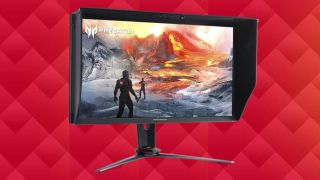
Specifications
Reasons to buy
Reasons to avoid
A little more affordable than the other 144Hz options on this page, the Acer Predator XB273K is the best 4K gaming monitor at that ideal refresh rate for value-seekers. During fast-paced games with settings maxed, there was no blur. G-Sync worked successfully--with both standard and HDR content-- to fight screen tearing when paired with an Nvidia graphics card. The monitor kept up well with other 144 Hz displays during our testing and even beat the Asus ROG Swift PG27UQ and Acer Predator X27, which are about $2,000 monitors when it came to input lag.
Regarding image quality, the Predator XB273K delivers pro-level color accuracy and contrast, reaching over 4,000:1, according to our testing, and over 2,000:1 after our calibration. HDR doesn't look as good as on monitors with FALD backlights, but we consider the Predator XB273K the next best thing.
For cheaper 4K displayers, see Best Budget 4K Monitors.
Read: Acer Predator XB273K review
Best 4K Gaming Monitor for HDR

Specifications
Reasons to buy
Reasons to avoid
If you want the best 4K gaming monitor for HDR movies and games, the Asus ROG Swift PG32UQX is an expensive but impressive buy. This is the first gaming-focused monitor with Mini LED. Thanks to that advanced backlight, we recorded a fantastic HDR contrast ratio of 180,820.8:1. And while an OLED screen like the Alienware on this page can offer deeper, purer blacks, the PG32UQX can get much brighter. It hit 1,627 nits with HDR during testing.
We loved watching HDR films on the screen, but there’s no Dolby Vision support. This won’t affect many games, but 4K Blu-ray discs and content from Netflix often use Dolby Vision. On the other hand, you do get support for 24p film cadences.
And as a gaming monitor, the PG32UQX is no slouch either. It performed admirably against other 144 Hz screens in our response time and input lag tests, even besting some, including the HP Omen on this page, in the latter. And the nifty OLED screen on the bottom uniquely relays helpful information, like refresh rate and CPU and GPU temperatures.
More: Asus ROG Swift PG32UQX review
Best Budget 4K Gaming Monitor
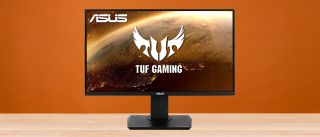
Specifications
Reasons to buy
Reasons to avoid
The Asus TUF Gaming VG289Q offers tremendous value for gamers looking to step up to 4K resolution without going bonkers on price. The VG289Q has a competent overdrive function, which helps reduce motion blur, and we didn't notice ghosting on the panel.
AMD FreeSync is supported here, although take note that the maximum refresh rate is just 60Hz (FreeSync will work down to 48Hz on this monitor). We can happily say that SDR content looked rich and colorful on the VG289Q, but shifting to HDR didn't really show any improvement.
But if you're just looking to dip your toes in the 4K gaming monitor market, it's hard to find any serious faults with the VG289Q. Be sure to check out our Best Budget 4K Monitors list for more value-priced offerings in this category.
Read: Asus TUF Gaming VG289Q review
Best 4K Gaming Monitor for Consoles

Specifications
Reasons to buy
Reasons to avoid
The market is full of 4K gaming monitors that cover a wide range of sizes and price points, but most are geared primarily toward gaming PCs. Sony takes a different approach with the Inzone M9 monitor, which is optimized for PCs and its PlayStation 5 gaming console.
The Inzone M9 ticks all the right boxes with a 27-inch IPS panel, 144Hz refresh with Adaptive-Sync support (AMD FreeSync and Nvidia G-Sync), a FALD backlight (96 dimming zones), and excellent color accuracy right out of the box. You'll also find dual HDMI 2.1 ports and a feature-filled Inzone app for easily configuring settings. Even the design of the Inzone M9 mimics that of the launch edition PlayStation consoles with a white and black motif.
Thankfully, Sony Inzone M9 provides a lot of bang for the buck, delivering excellent gaming and color performance, nice little touches (like an integrated KVM switch for running the monitor on a console and a PC), and an attractive price of $899.
Read: Sony Inzone M9 27-Inch 4K Monitor review
Quick Shopping Tips
When seeking the best 4K gaming monitor for you, consider the following:
- 4K gaming requires a high-end graphics card. If you're not using a GeForce RTX 4090 or Radeon RX 7900 XTX, you'll want at least a GeForce RTX 3080 or Radeon RX 6900 XT to game at high-quality settings. Visit our Graphics Card Buying Guide for help.
- G-Sync or FreeSync? A monitor's G-Sync feature will only work with PCs using an Nvidia graphics card, and FreeSync will only run with PCs carrying an AMD card. You can technically run G-Sync on a monitor that's only FreeSync-certified, but performance may vary. We've seen negligible differences in mainstream gaming capabilities for fighting screen tearing between the two. Our Nvidia G-Sync vs. AMD FreeSync article offers an in-depth performance comparison.
- 4K and HDR go hand-in-hand. 4K displays often support HDR content for extra bright and colorful images. But for Adaptive-Sync optimized for HDR media, you'll want a G-Sync Ultimate or FreeSync Premium Pro (formerly FreeSync 2 HDR) monitor. For a noticeable upgrade from an SDR monitor, opt for at least 600 nits brightness. You can learn more from our glossary page on HDR and our buying guide for picking the best HDR monitor.
So you've made it this far and still haven't found something that seems like the right fit for your gaming desires? Well, we've recently looked at a couple of other 4K monitors that, while they don't quite make our best 4K gaming monitor list, are still worth considering.
Acer's Nitro XV282K is a compact 28-inch 4K gamer with 144Hz refresh, vibrant, accurate colors, plus other premium features. Its primary downsides are average contrast, light gamma and its $900 price.
And while not strictly a gaming screen, Asus' ProArt PA32UCG delivers a phenomenal, accurate image, excellent HDR (thanks to a Full-Array Mini-LED backlight and 1700-nit peak brightness) and 144 Hz refresh over its DisplayPort. The 5ms response time, though, will disqualify it from consideration for many gamers. And the $5,000 price also means it's likely to be a niche display for professionals who want to game on the side.
For more guidance picking a monitor of any resolution--gaming or otherwise--check out our PC Monitor Buying Guide and list of the Best Computer Monitors.
MORE: Best Gaming Monitors
MORE: How We Test Monitors
MORE: All Monitor Content
Stay on the Cutting Edge
Join the experts who read Tom's Hardware for the inside track on enthusiast PC tech news — and have for over 25 years. We'll send breaking news and in-depth reviews of CPUs, GPUs, AI, maker hardware and more straight to your inbox.

Christian Eberle is a Contributing Editor for Tom's Hardware US. He's a veteran reviewer of A/V equipment, specializing in monitors. Christian began his obsession with tech when he built his first PC in 1991, a 286 running DOS 3.0 at a blazing 12MHz. In 2006, he undertook training from the Imaging Science Foundation in video calibration and testing and thus started a passion for precise imaging that persists to this day. He is also a professional musician with a degree from the New England Conservatory as a classical bassoonist which he used to good effect as a performer with the West Point Army Band from 1987 to 2013. He enjoys watching movies and listening to high-end audio in his custom-built home theater and can be seen riding trails near his home on a race-ready ICE VTX recumbent trike. Christian enjoys the endless summer in Florida where he lives with his wife and Chihuahua and plays with orchestras around the state.
-
Muggi1909 hey nice job there, but can you pls take a look on this monitor too, I think personal its the best buy for the bucks if you want a 4k 144hz gaming monitor for around 800 dollars or less :)Reply
Acer Nitro XV273 -
spoidz Did Prices just explode all of a sudden?Reply
Some of the best are back up to $2000 MSRP and not far below at retail. I thought we were seeing lower $1000's a week or so back.
Or maybe I just haven't been noticing, but I have been web "window shopping" these last weeks or so. -
ryzengamer The ASUS VP28UQG freesync 1ms gaming monitor is good and affordable. It comes with a 3 years on site warranty here.Reply -
BulkZerker Replyspoidz said:Did Prices just explode all of a sudden?
Some of the best are back up to $2000 MSRP and not far below at retail. I thought we were seeing lower $1000's a week or so back.
Or maybe I just haven't been noticing, but I have been web "window shopping" these last weeks or so.
This list looks like the same one they released last time. If they haven't reviewed any standout 4kmonitors why change it? -
fry178 anything past 500$ is kind of useless, unless you also using it to "work" on it.Reply
i can buy a 49" 4K tv with 120hz and local dimming for sub 1000 (even brands like sony),
and use a lower res like 1080 to play (tvs upscale 1080p content properly),
which would also reduce (4K related) input lag a bit and will not require a 1070. -
ivoleiden What about the Samsung CRG90 ? 49", super ultra wide 5120 x 1440 , HDR 1000, 120hz (overclockable to 144), native freesync. I ordered one, it's coming tomorrow to replace my 32" QHD 60Hz NoHDR really looking forward!!! only 1,200 Eur!!!Reply -
bendvis Why is the Razer Raptor 27 listed as the best 4k gaming monitor when it's a 1440p screen?Reply -
JonnyDoom Anything less than 32 inch is to small for 4K. Things will be small and far away. 2k works though at around 28 inch.Reply -
mac_angel Replyspoidz said:Did Prices just explode all of a sudden?
Some of the best are back up to $2000 MSRP and not far below at retail. I thought we were seeing lower $1000's a week or so back.
Or maybe I just haven't been noticing, but I have been web "window shopping" these last weeks or so.
Typically stores will jack up the prices before Black Friday and then they can list a sale price and post a bigger difference - "Now $800 off the previous price" -
mac_angel I'm curious with TomsHardware is going to start reviewing FreeSync TVs for gaming. You're bringing up the future of 4k OLED monitors coming, and Alienware's 55" being around $4000. Samsung's 8000 series and up (55" and up) have 4k, HDR and FreeSync. And LG's new firmware for most of their OLED TVs also enable FreeSync. All are much cheaper than Alienware's, even at bigger sizes.Reply
